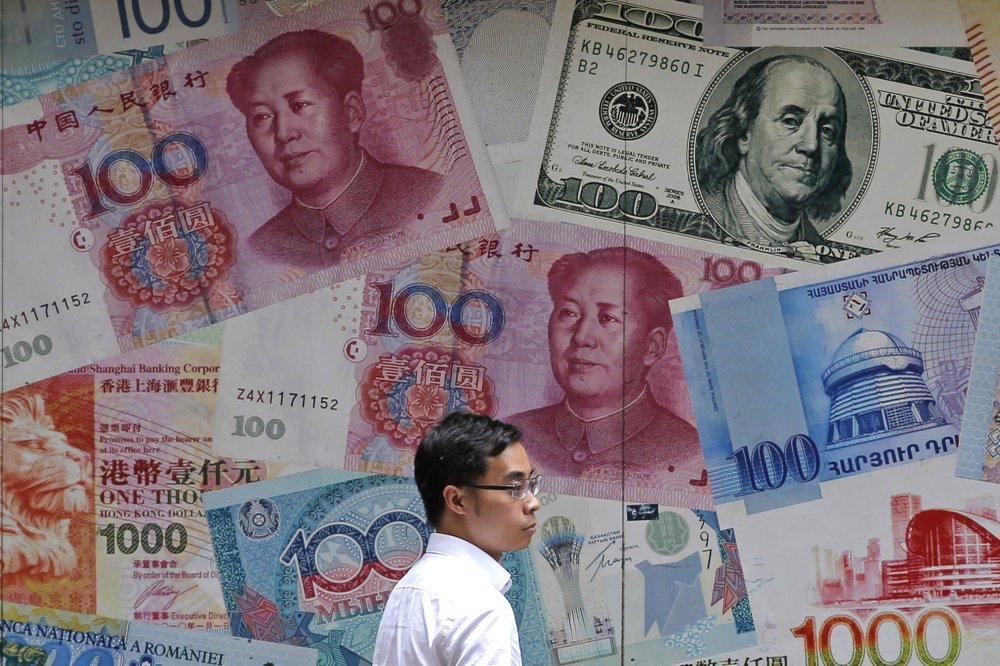China decided Monday to meet President Donald Trump’s latest tariff threat with defiance, letting its currency drop to an 11-year low and halting purchases of U.S. farm products.
The moves, which came four days after Trump threatened more taxes on Chinese imports, knocked stock markets worldwide into a tailspin. On Wall Street, the Dow Jones Industrial Average was down more than 850 points by mid-afternoon.
Earlier, stocks tumbled from Shanghai to London on fears the escalation in U.S.-China trade tension will drag down a global economy that is already weakening.
Raising worries that China will wield its currency as a weapon in a trade war, Beijing let the Chinese yuan weaken to the politically sensitive level of seven to the U.S. dollar for the first time since February 2008.
Also Monday, China’s official Xinhua news agency reported that Chinese companies have stopped buying U.S. farm products — a direct shot at Trump supporters in rural America.
Together, the currency devaluation and suspension of farm purchases suggest that China has decided to stand tough, rather than cave in Trump’s threats.
“The Chinese side won’t submit to the US,” tweeted Hu Xijin, editor-in-chief of China’s hardline Global Times newspaper.
The weaker yuan makes Chinese exports less expensive in foreign markets. It also helps offset the impact of U.S. tariffs on Chinese products.
The Chinese currency hit 7.0391 to the dollar by late afternoon, making one yuan worth 14.2 cents. The level of seven to the dollar has no economic significance but carries significant symbolic weight.
“The thought of a currency war is crossing more than a few traders’ minds,” Stephen Innes of VM Markets said in a report.
Trump promptly took to Twitter to denounce the move as “currency manipulation.” He added, “This is a major violation which will greatly weaken China over time.”
China’s central bank blamed the yuan’s drop on “trade protectionism” — an apparent reference to Trump’s threat last Thursday to impose tariffs Sept. 1 on the $300 billion in Chinese imports to the United States in addition to the $250 billion he’s already targeted.
The U.S. and China are engaged in a bitter dispute over allegations that Beijing steals trade secrets and pressures foreign companies to hand over technology as part of an aggressive campaign to make Chinese companies world leaders in advanced technologies such as artificial intelligence and quantum computing.
The weakness of the yuan, also known as the renminbi, or “people’s money,” is among U.S. grievances against Beijing. American officials complain that a weak yuan gives Chinese exporters an unfair price edge in foreign markets and helps swell the massive U.S. trade deficit with China.
The U.S. Treasury Department declined in May to label China a currency manipulator but urged Beijing to take steps “to avoid a persistently weak currency” and warned that it would be watching closely.
China’s central bank sets the exchange rate each morning and allows the yuan to fluctuate by 2% against the dollar during the day. The central bank can buy or sell currency — or order commercial banks to do so — to dampen price movements.
It appears “the currency is now also considered part of the arsenal to be drawn upon,” Robert Carnell of ING said in a report. He said Monday’s move might be part of “a concerted series of steps aimed at pushing back at the latest U.S. tariffs.”
Until now, economists had expected the People’s Bank of China, the Chinese central bank, to intervene and put a floor under the currency if it threated to breach the seven-to-the-dollar level.
A central bank statement Monday blamed “unilateralism and trade protectionism measures,” a reference to Trump’s tariff hikes. But it tried to play down the significance of “breaking seven.”
“It is normal to rise and fall,” the statement said. It promised to “maintain stable operation of the foreign exchange market.”
Chinese leaders have promised to avoid “competitive devaluation” to boost exports by making them less expensive abroad — a pledge the central bank governor, Yi Gang, affirmed in March. But regulators are trying to make the state-controlled exchange rate more responsive to market forces, which are pulling the yuan lower, partly on fears Trump’s tariffs will weaken the Chinese economy.
The yuan has lost 5% since February.
Globally, a weaker yuan might lead to more volatility in currency markets and pressure for the dollar to strengthen, Louis Kuijs of Oxford Economics said in a report. That would be “unwelcome in Washington,” where Trump has threatened to weaken the dollar to boost exports.
A weaker dollar “would be bad news” for Europe and Japan, hurting demand for their exports at a time of cooling economic growth, Kuijs said.
The Chinese central bank tried to discourage speculation last August by imposing a requirement that traders post deposits for contracts to buy or sell yuan. That allows trading to continue but raises the cost.
Beijing imposed similar controls in October 2015 after a change in the exchange rate mechanism prompted markets to bet the yuan would fall. The currency temporarily steadied but fell the following year.
The Chinese are well aware of the pain the trade war is causing American farmers, a loyal part of Trump’s political base. Their retaliatory tariffs on $110 billion in U.S. products targeted soybeans and other key agricultural products. To ease the pain in rural America, Trump has rolled out two packages of farm aid worth a combined $27 billion.
Monday’s Xinhua report said that Beijing would “not rule out the possibility of levying additional tariffs” on U.S. farm imports. Xinhua said Trump’s plan to tax another $300 billion in Chinese imports “seriously violated” a ceasefire agreed to in June by Trump and Chinese President Xi Jinping.
(AP)












One Response
Can’t the degenerate racist lying adulterer fix this with his pal Xi in 15 minutes like everything else???